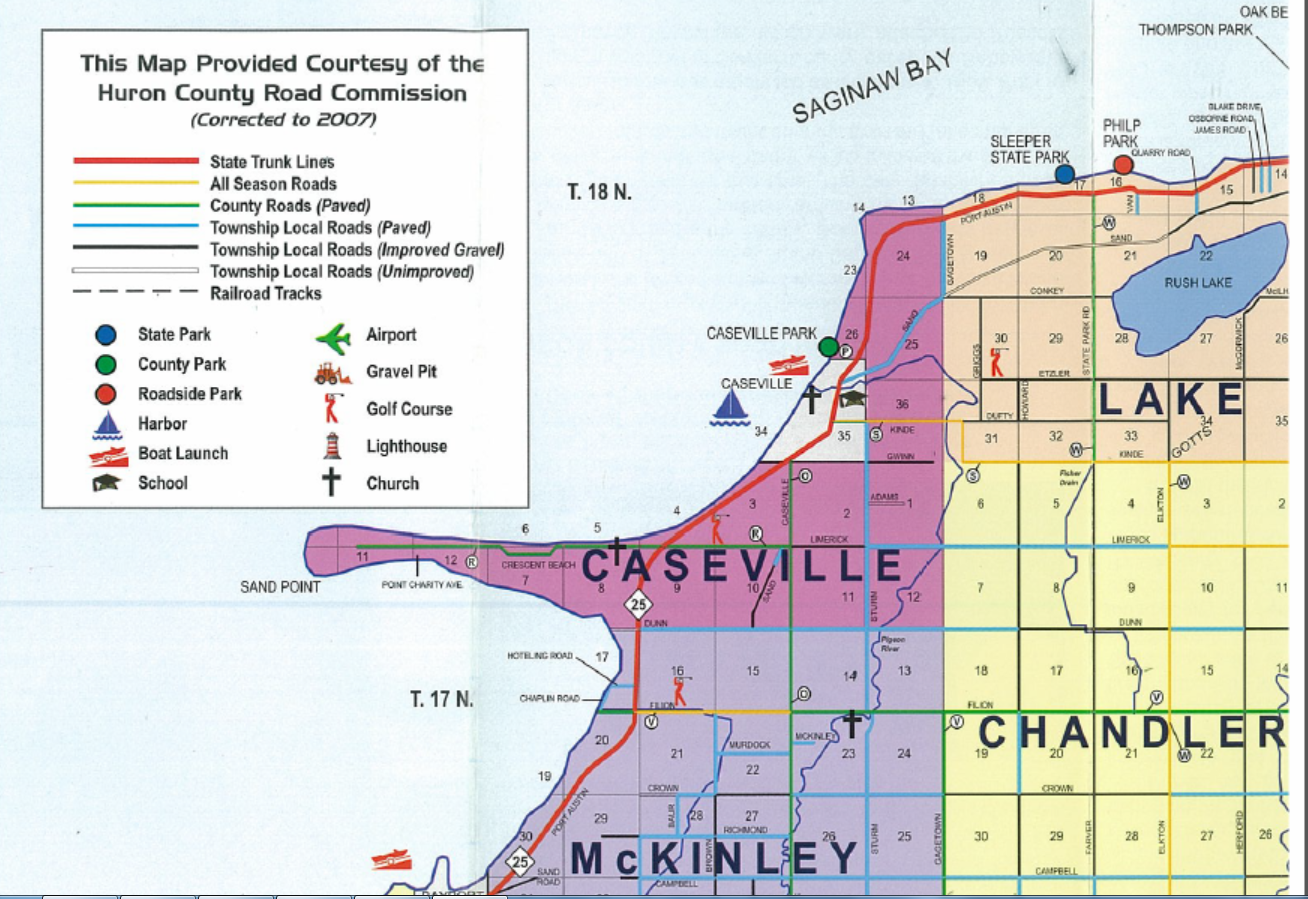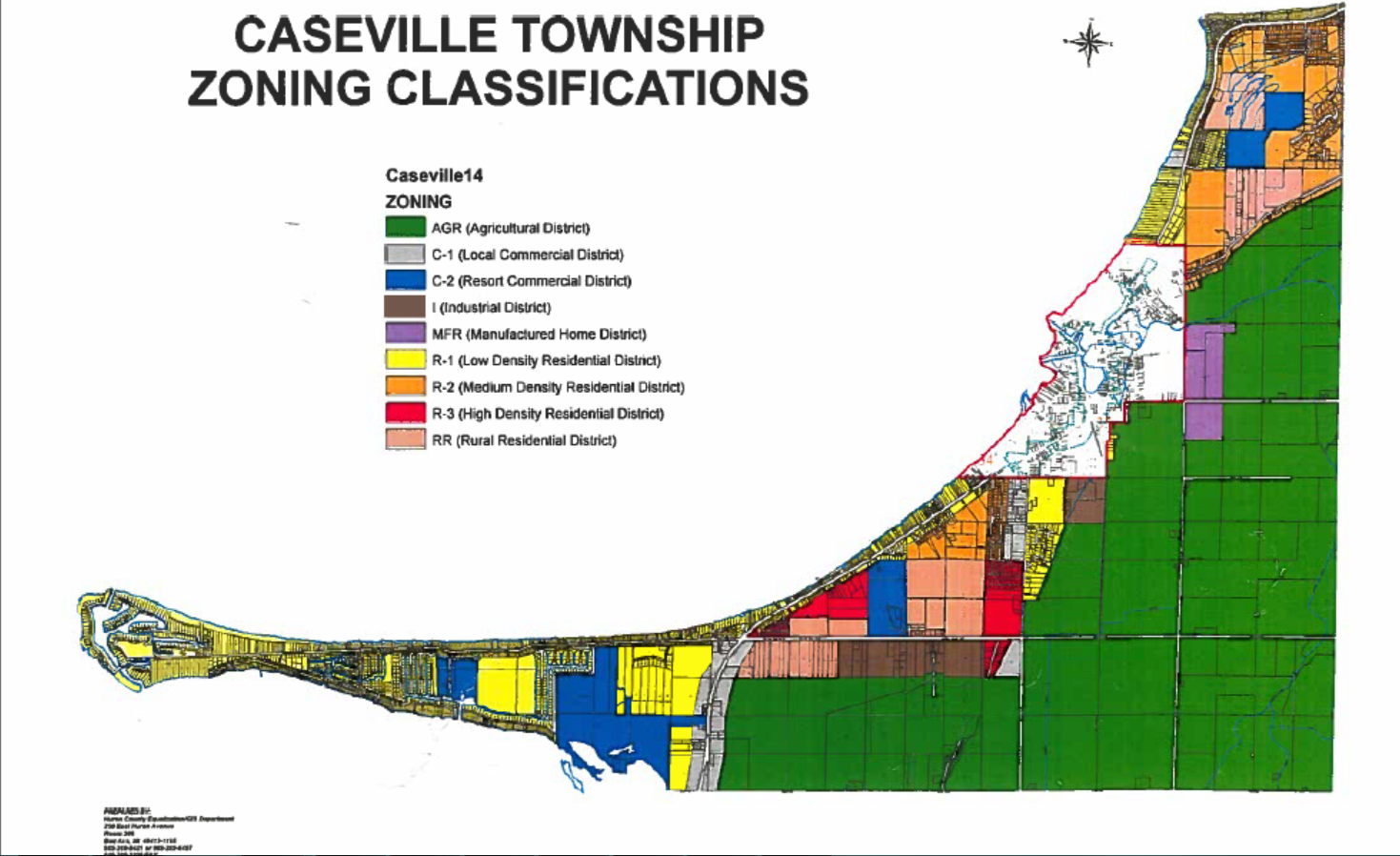About Us
Caseville Township Boundaries and Map

Caseville Township Zoning Map

A History of Caseville - a 1884 Perspective
** The following excerpt is taken from The Album of Huron County, written in 1884, supplied courtesy of the Caseville Historical Society. It provides an interesting historical perspective of Caseville and its surrounding area. **
"Caseville is in the northern tier of townships, and is numbered 17 north, of range 10 east. It is bounded on the north by Saginaw Bay, on the east by the Township of Chandler, on the south by Winsor Township, and the waters of the Saginaw Bay make her western line. The first meeting of organization and the election of officers was held April 2, 1860, in the school-house near the mouth of the Pigeon River. At this election, Alexander Wheeler was chosen Supervisor, Abraham A. Fox, Treasurer, and Francis Crawford, Clerk. It embraced the territory now occupied by Brookfield, Chandler, Fair Haven, Grant, Oliver, and Winsor. Some of the early incidents are mentioned in the history of the village of Caseville. The first funeral service was read by Geroge Cleaver. The first sermon was delivered in the school-house at the mouth of the Pigeon River by Rev. Mr. Cross.
The earlier settlers came by the way of Pointe aux Barques, following the Indian trail along the beach. There were about here at this period quite a number of Indians, belonging to the Chippewa tribe, who had their principal town at Shebahyonk. They were peaceful, and mixed with the settlers a great deal. For arms they carried the old flint musket and tomahawk. They hunted, fished some, and made maple sugar, using birch-bark troughs to catch and hold their sap, which they boiled down in brass kettles. These kettles had been so long in their possession that even the proverbial memory of the oldest Indian was taxed in vain when asked to give an account of how he got them or whence they came.
This township is well supplied with schools. In addition to the graded school in the village, there is one on section 12, one on section 21, and two in school district No. 1. Two of the buildings are veneered with brick; the rest are frame.
The township is well watered by the Pigeon River, which meanders through it, and other little streams. The soil is a dark clay loam, easily tilled when cleared, and very productive. Settlers are constantly coming in, new lands are brought under cultivation, and new buildings are put up. The old farmers are improving their homes, and gradually bettering their financial condition.
The following is a list of the Supervisors from the organization of the township to the present time: SUPERVISORS. Alexander Wheeler, 1860-1; Francis Crawford, 1862-3; George Anderson, 1864; Francis Crawford, 1865-7; T.B. Woodworth, 1868-75; James Adams, 1876-82; George Cleaver, 1883, and Gustave A. Flach, 1884.
CASEVILLE. This pretty little village is located on Saginaw Bay, at the mouth of the Pigeon River. The residences and most of the business houses are built on the bluff, which is about 30 feet above the Bay. The Pigeon River, bordered by beautiful forest and shade trees meanders gracefully through the town. It is in the township 18 north, of range 10 east. It is 108 miles north and 8 miles east of Detroit, 20 miles southwest of Point aux Barques, and 48 miles north of the Saginaw River. There is a natural harbor here, with a depth of from 10 to 11 feet of water. It is considered the best harbor north of Sand Beach. With a moderate expenditure of money it could be made one of the best harbors on the coast. There are two docks for the accommodation of steamboats and vessels, which come regularly, bringing goods and carrying away the products of the town and surrounding country. Caseville has been recently supplied with another means of transportation, in the Pontiac, Oxford, & Port Austin Railroad, which was commenced in 1881 and completed in 1883. The terminus of the road is at this place, with headquarters in Pontiac
The first settlers were Reuben Dodge, wife and two children, who came in 1840, from Maine. He built a little cabin at the mouth of the Pigeon River on section 35, and settled down in life, devoting himself to hunting, fishing, and farming. Mr. Dodge is dead, but his widow is still living and resides in the village. The first child born here or in the township was their son, Reuben Dodge, Jr., who was also the first child born in the territory now embraced by Caseville Township.
In 1852 William Rattle, representing the interests of Leonard Case, of Cleveland, came and put up a saw-mill. The name then given to the town was Port Elizabeth, in honor of Mr. Rattle's wife. Mr. Case's interest here consisted of 20,000 acres of land. Mr. Rattle managed the business until 1856, when the Pigeon River property passed by purchase into the possession of Francis Crawford and George Martin, of Cleveland. At this time the nearest post office was Port Austin.
In 1858, Mr. Crawford purchased George Martin's interest, and has since made Caseville his home. The first hotel here was opened by Robert Squires, in 1856, and was built at the head of what is now known as Main Street. Mr. J.W. Kimball carried the first mail into town, in 1858, bringing it from Port Austin. The first wedding celebrated in the village and the first in the township was in 1855, the contracting parties being Moses C. Gregory, who located here in 1853, and Sarah Dodge. They now reside on section 1, where they have a fine, large farm, surrounded by a numerous family of worthy and affectionate children.
The first floating craft, other than a birch-bark Indian canoe, that landed at Caseville, was in the spring of 1853. It was the schooner "Ohio", Captain John Armour commanding, who took on a cargo of shingle bolts for Cleveland.
BUSINESS INTERESTS. There are now five salt wells in the village and three salt blocks, one pan and two stream, all owned by Mr. Francis Crawford. In connection with these great enterprises, he manufactures lumber, shingles, lath and salt barrels for his own use. He also has a grist-mill, with two run of stone, a general supply store and a hardware store, keeping in this department all kinds of agricultural implements. The first salt well was opened in the spring of 1871, at a depth of 950 feet. Later it was sunk down 1,764 feet, the present depth. Recently the fifth well was opened at a depth of 1,850 feet. The annual production from the three salt blocks is from 40,000 to 50,000 barrels. The capacity is about 400 barrels daily. The saw-mill cuts out about 3,000,000 feet annually. In former years, they manufactured from seven to eight million feet. The timber is rafted or floated down the Pigeon River and brought by mail. The flouring mill, erected in 1870, was the first built in the township. The lumber manufactured now is principally pine, with some ash, oak, and elm.
The Pigeon River salt and iron works were started in 1873 by Messers. Edison, Sanford, and Crawford. The furnace was moved from Black River, Ohio, and has a capacity of 30 tons of pig iron daily. The ore was shipped from Marquette and Escanaba. The works were run about a year, and then the blast went out, owing to the depression in the iron trade and the high price of fuel. In 1879 the property changed hands, additional works were put in and the furnace was started again. It ran for a while and then closed. The property again changed hands, and is now owned by A. G. Stone, of Cleveland.
J.A. Holmes is one of the enterprising merchants of Caseville. He has a large assortment of dry goods, groceries, and general merchandise, which includes an extensive line of furniture. He cast his fortunes with the good people of Caseville in 1871. Dr. J.W. Jackson opened in the spring of 1882 a very fine line of drugs, medicines, etc. He is also a practicing physician, with a good list of patrons. Dr. S.J. Henderson has also a drug store in connection with his practice.
The Poss House is a fine hostelry, presided over by J.R. Poss, and was opened to the public in 1877, being the second hotel started by him in the village. He is also an extensive farmer, having three large farms under cultivation.
There are two other hotels in the place, besides the Poss House, namely: The Central House, kept by E. Midline, and the Gonder House, kept by Conrad Gonder.
W.J. Dell keeps a general grocery store, and a meat market adjoining. There is also a market, kept by W. Loosmore.
James Adams, an old resident of Caseville, showed his faith in the future of the town last spring by opening a store with a large stock of general merchandise at the head of Main Street.
The ladies of the village and vicinity are supplied with those indispensable articles of millinery so necessary to their adornment, by Mrs. Alice Lloid.
There is also a blacksmith and wagon shop at Caseville, owned by Neil Connelly, and a shoe shop by R. Lankin.
The legal profession has in it an able representative at this point in the person of T.B. Woodworth, the present worthy County Attorney.
Hiram Kellsey is the representative of Uncle Sam in the post office. Mails are received daily by rail, and daily each way by stage. In January, 1874, T.B. Woodworth, Esq. started the Caseville Advertiser, a weekly paper. He published the same until 1876, when, to the regret of the citizens of the town, he sold out to the Huron County News Company, and the paper was moved to Port Austin."
